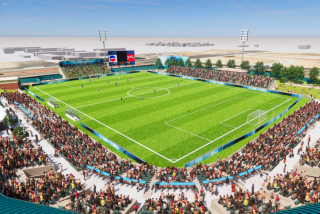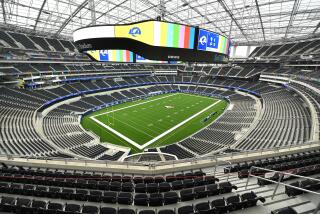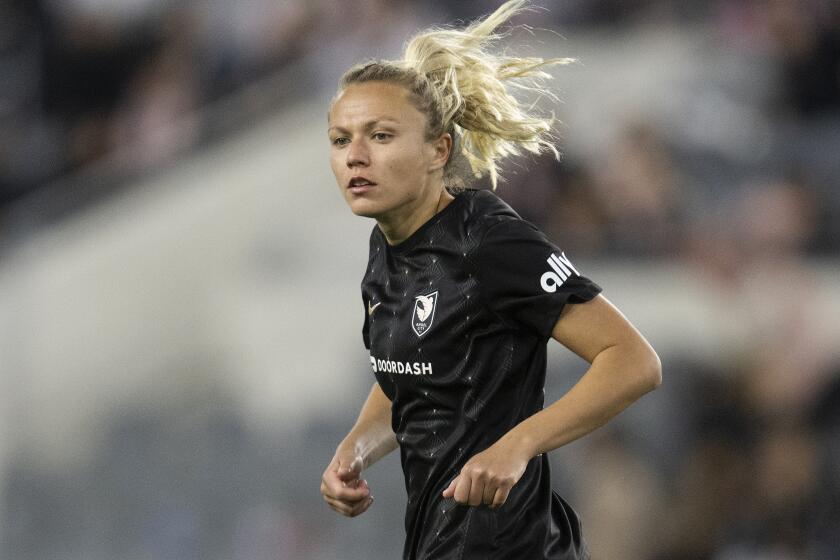When the field is the goal
The Little Saigon Soccer Assn. had everything it needed to get started: four teams, soccer equipment and a zeal for competition.
But when the budding league tried to find a field to play on, the grassy lawns, soccer fields and baseball outfields were always taken. In the crowded core of Orange County, the demand was simply too high.
So when an established league offered to give Little Saigon members field time for $150 a game, they jumped at the chance. And though they cringed at paying another league to use a public field, organizer Tuan Pham was told it was the only way they would be able to play soccer.
“We wanted what they had, and that was the fields,” Pham said. So for several years, the upstart paid the United Latin Soccer League to use city-owned fields on weekends, with referees and equipment provided as part of the deal, he said. Little Saigon’s rosters steadily grew.
For years there has been a black market in subletting fields at public parks in soccer-crazy communities like Santa Ana. To feed the crush of teams, league presidents sometimes emerge as strongmen, brokering fields and selling game time to the highest bidder. Oversight is sometimes lax. City officials in Santa Ana, for instance, admit that they looked the other way for years.
Cities throughout Southern California -- Los Angeles, Long Beach and Garden Grove among them -- have had problems with field brokering, in which soccer leagues with permits for public fields trade, bargain or even sell their allotted time and space.
For city officials, it’s a delicate task to bring order to the behind-the-scenes battle for fields, a rivalry sometimes as spirited and bitter as the games themselves.
The scramble for playing fields is particularly acute in Santa Ana, where more than 12,000 registered soccer players vie for space on just 29 city fields. The city of 350,000 has one of the highest ratios of players to fields in the region.
--
‘I was not profiting’
Allegations of field brokering in Santa Ana came into focus last year when the Little Saigon league asked city parks commissioner Ken Nguyen if it could reserve city fields without paying another league first.
The answer, of course, was yes.
“I was so surprised and disgraced,” Nguyen said. “I was very upset because it’s not right. You cannot profit on a public property.”
Leonel Perez, president of the United Latin Soccer League, acknowledged he accepted payments from the Little Saigon Soccer Assn. -- $130 per game, he said -- but said the association had agreed to play as a special Vietnamese division of his league and that the fees were for referees and equipment only.
“Everything they paid were for expenses,” he said. “I was not profiting.”
The city could not prove that money was exchanged for field access -- with no paper trail of payments, field subletting is often hard to prove -- but Nguyen reported at a meeting that leagues across central Orange County were paying other leagues as much as $1,300 per day to use fields.
Santa Ana officials have tried to clamp down on the soccer field black market by centralizing their field reservation system, instituting new rules, stepping up enforcement and giving priority to locals, youths and nonprofits. The city has disciplined a handful of leagues for brokering fields, giving them 90-day suspensions.
In Los Angeles, Charles Singer, a parks department supervisor who used to administer field permits, said problems with subletting led the city to start random monitoring and create an electronic database of permits.
“It’s one thing to exchange field time with a neighboring team without exchanging money,” he said, “but when someone is trying to make a business out of it, then it becomes fraud.”
--
A magnet for soccer
The fervor for soccer came in tandem with the influx of immigrants. So as Santa Ana transformed into the hub of Orange County’s Latin American immigrant community, it also became a soccer magnet.
For youngsters just learning to dribble to adults playing on elite clubs, soccer is lifeblood in Santa Ana. Spanish-language magazines track teams and up-and-coming stars. A support industry of uniform designers, equipment sellers, referees and food vendors makes a living supplying the necessities of each match. Every field is a swirl of activity.
Leagues also compete for school fields. A clash between two youth soccer leagues over distribution of field time at a Santa Ana middle school intensified in recent weeks, with hundreds of young players turning out in uniform at a school board meeting before the district brokered a compromise earlier this month.
Unlike summer baseball and fall football, soccer is played year-round in Southern California, and competition for fields never lets up. Nor does the strain on grass fields, some of which have turned into dust bowls because of overuse. More are being converted to synthetic turf, allowing for near-unlimited playing time.
For a while, the city took a hands-off approach to scheduling field time, ceding the complicated, divisive task to soccer association presidents. That enabled an underground field trade to take root.
“Soccer league presidents were brokering fields and giving them to the top offer,” said Gerardo Mouet, executive director of the city’s parks agency.
“Before you knew it, they were controlling the fields.”
To make access more fair, starting in 2004 the city overhauled its field booking rules, formed a committee to review reported violations and required leagues to submit the name and address of each player to weed out out-of-towners.
Last year, when the city installed synthetic turf at its stadium in the heart of the Civic Center, opening up more time for soccer, a single league president reserved the field for the entire year. So the city instituted a lottery.
Retired police officers now patrol the parks, reporting teams that are using fields they’re not entitled to.
The city eventually plans to target other unregulated aspects of soccer, including requiring background checks for coaches and player insurance for every athlete.
GIS mapping is being used to route young players to practice at fields within walking distance. Another proposal would require photo IDs, ensuring that the players on the field are the ones who reserved it. In January, the city will require all soccer leagues to register as either a nonprofit or a business, to delineate between those in it purely for recreational reasons and those turning a profit.
Officials believe the reforms are working, slowly but steadily.
The Little Saigon Soccer Assn., now a 20-team league with hundreds of players, competes every Sunday on fields it reserves from the city of Garden Grove.
Pham, the league organizer, said he regrets the wasted expense of subletting, but hopes it serves as a lesson.
“We don’t want every other team to go what we went through,” he said. “We came out in tears.”
--







